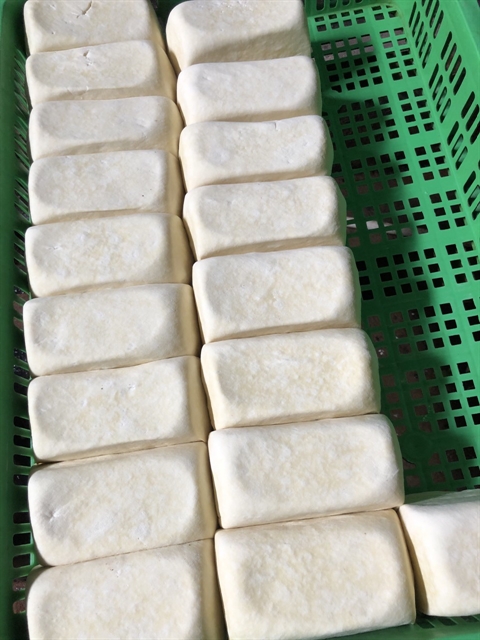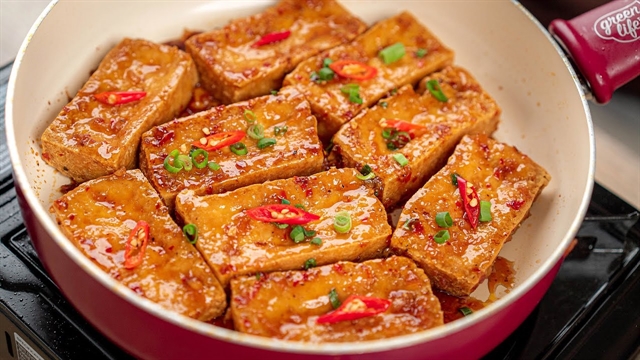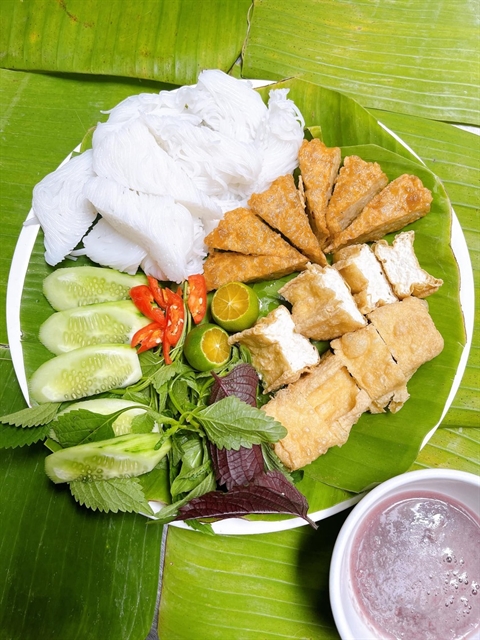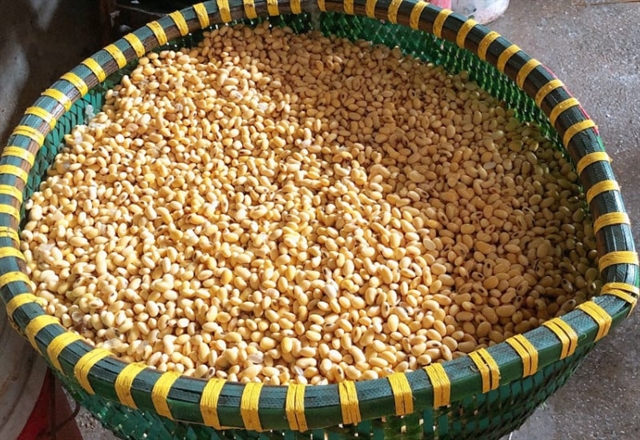Hoàng Lan
I became fascinated with tofu -- a soft, pale, protein-rich food made from soybeans, called đậu phụ in Vietnamese -- for its distinctive fragrance and buttery texture during my recent trip to Trà Lâm Village in Bắc Ninh Province.
Unlike tofu produced in other laces, the version made in Trà Lâm, locally called đậu phụ gù (literally "humpback tofu") stands out for its larger size and unique shape. Each block weighs about 500 grams — more than three times the size of a regular tofu block (around 150 grams) — and has a characteristic hump formed through a traditional production method of pressing the tofu twice in a wooden frame.
There are many dishes made with tofu, such as đâu phụ mắm tôm (fried tofu served with shrimp paste mixed with lime juice and chilli, eaten with rice vermicelli and fresh balm herb; đậu phụ tẩm hành lá (fried tofu topped with fried green onion); cháo đậu phụ (fried tofu eaten with rice and black bean porridge, a cooling dish for the summer heat); ốc om chuối đậu (tofu braised with green banana and snails); among others.

Blocks of raw tofu made in Trà Lâm Village, Bắc Ninh Province. Photo danviet.vn
In the past, when the country was very poor during and after prolonged wars, Vietnamese people in general, and locals in Trà Lâm Village in particular, often braised tofu with plenty of salt, fish sauce and curcumin so it could be eaten sparingly over several weeks.
A local elder, Lục Văn Chiêm, 90, said legend has it that in 1640, the well-known Zen master Chuyết Chuyết, during his tour of the region, stopped at Trà Lâm. Seeinghow hard the locals worked, he decided to teach them how to make tofu. The villagers were delighted to learn, as from then on they had a tasty dish to enrich their daily meals.

There are many dishes cooked with tofu, including fried tofu with fish sauce and green onion. Photo fptshop.com.vn
“Over time, thanks to its buttery texture and delicious taste, đậu phụ gù began to be sold to surrounding villages such as Tư Thế, Bút Tháp, Phương Quan and others,” said Chiêm, adding that since then, words spread quickly and Trà Lâm humb tofu has become an indispensable dish not only in locals’ daily meals but also at major festivals and celebrations such as Tết (Lunar New Year) and weddings.
Chiêm said that in the past, almost every household in the village made tofu as a side trade alongside the main income from two annual rice crops. Today, however, the number has fallen to about 370 households, down from 500.
The đậu phụ gù is sold not only in Bắc Ninh but also in surrounding provinces and cities such as Hà Nội, Hải Phòng, Hưng Yên and others, he added.

A lot of eaters including foreign tourists like rice vermicelli with fried tofu and shrimp paste. Photo vinwonders.com
In the past, makers often bought soybeans grown in the northern mountainous provinces of Cao Bằng and Lạng Sơn to make tofu, said Chiêm.
“The soybean, with its distinctive fragrance and buttery texture, makes the tofu unforgettable, according to many eaters,” he said, adding that once transport improved, makers began importing soybeans from the US and Canada at a lower price compared with those from Cao Bằng and Lạng Sơn.
Chiêm, whose family has been making tofu for four generations, said that to produce quality tofu, makers must be careful in selecting the soybeans and in the processing methods such as soaking, grinding and pressing at the right temperature. “Pressing twice is an important factor in creating the characteristic form of đậu phụ gù," he said.

A basket of soybeans used to make tofu. Photo danviet.vn
Since 1993, with access to the national electricity grid network, tofu makers in Trà Lâm have been able to use machines for production instead of making everything by hand as before.
As a result, locals’ living standards have improved significantly. Many now have money to build multi-storey houses, buy cars, and invest large sums in their children’s education abroad, said Trà Lâm Village Chief Nguyễn Đình Quân. VNS